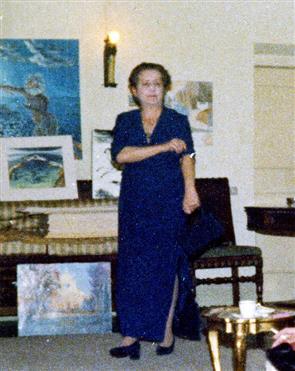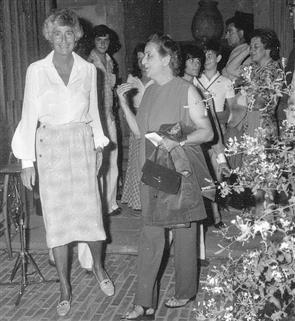


Alexandra de Hadeln - Balaceano (1911-1977)
Draft for a biographie (4)



1973-1975
She organises two successive sculpting and painting exhibitions, at the “Galerie Chantepierre”, Aubonne (1973) and “Galerie-Club Migros”, Lausanne (1974). The latter is opened by J.P. Delamuraz (1936-1998), mayor of Lausanne and the varnishing day is celebrated in the presence of clowns in a circus tent. Since her husband’s death she regularly goes to the Knie circus where she is even admitted during rehearsals. The circus lights, trapeze artists and other acrobats fascinate her, but she admires the clowns above all, and paints several of their portraits. She briefly meets Charlie Chaplin in Vevey, gives a painting to Federico Fellini and an album of clowns to the children of the Prince of Monaco. Through a Lausanne lawyer- the same she mandated to start a lawsuit against the doctors- she discovers the Argentario peninsula in south-west Tuscany.
Her life will be thereon split between frequent trips by car to Switzerland, Florence and the Argentario.
L’Argentario is a discovery. She paints a series of works in Porto Ercole and Porto Santo Stefano, considered by some as among her major works. In any case she shows a strong mastery of her art and surprises by her force of expression and the violence of her palette. She even has the project to publish an illustrated book on the peninsula and commissions a local author to write the text. But the project is abandoned. Inspired by Etruscan masks, she makes a series of Bacchus heads, of which one is used as a label on olive oil and chianti bottles. She sculpts a lot, strange persons often inspired by her series on tramps. Enigmatic but none the less happy creations, where birds and fish come to the rescue of questioning interrogators.
1975
Introduced by Susanna Agnelli, mayor of the peninsula, Alexandra organises two painting and sculpture exhibitions in Argentario, in “Studio Dino Rossi”, Porto Ercole, and “Galleria Il Molo”, Porto Santo Stefano: The varnishing is followed by a guitar concert in the village square, as though music had to complete her work by making it sing. Alexandra didn’t play any musical instrument although her paintings are filled with a multitude of instruments, pan flutes, accordions, guitars, trumpets, clarinets or mandolins.
When she painted the record player was ever present. First the old 78 records of popular Romanian folk music (“Sarba Oltreneasca”, “Foaie Verde” or “Doina Din Nai”), from Bucharest in 1937, then Paul Robeson (“The Killing Song” or “Congo Lullaby”) discovered in the US before McCarthyism, Andalusian flamenco (Spanish ballet music by Pilar Lopez) , popular Italian folk singers ( e,g,the guitar trio Andres Segovia ) or circus orchestra music.
1976
She had a row with her Swiss lawyer from Argentario, to the point of asking the carabinieri’s protection, for heaven knows what more or less imagined threat, then decided to move to Switzerland fearing that Italy might become like her Romania, another country in “communist hands”. At the time Aldo Moro advocated an alliance of the left with Berlinguer’s party. In a radio interview she declared herself “socialist”, but one could doubt her convictions for politics were never her calling. Once she even declared that “the poor are happy” as long as they are not made aware of their misery…de Gaulle and the rebellious Malraux remained in her high esteem, as did certain French painters, irrespective whether they were communist or not. Neither did religion appear to attract her. Although she sculpted a crucifix in the past for which her husband posed, and if some work during the war was impregnated with references to the Passion, it was no doubt more symbolic than the result of a strong faith. Her faith, believing but little practiced, was to meditate at length in front of frescoes by Domenico Ghirlandaio in the Santa Trinita church in Florence, or the Fra Angelicos in the Orvieto cathedral.
In preparation for the “Fête des Vignerons” in Vevey, in 1977, she made the statue of a Bacchus seated on vineleaves, intended to decorate the village fountain in Genolier. Despite the village mayor’s support, the village council finally refused the offer. A second statue on the same theme remained at a draft stage. She also made a series of six small statues of a pair of lovers, meant to be used with some small bowls as “ashtrays”. They are offered to the Gucci company to be commercialised, but the latter judge them too erotic for their customers.
Such refusals, far from discouraging her, make her more combative than ever. But time is running out.
She organises her last two exhibitions in Switzerland, one in the Galérie de la Cathédrale, Fribourg, the other soon after in the Galérie Picpus, Montreux, both showing paintings and sculptures. For these exhibitions she paints her largest picture ever (1’40x2’30m) representing three clowns playing the trumpet on the seaside by moonlight. The galleries refuse the work as its size takes up too much space. For a while she also lends her Florentine paintings to a Tuscan trattoria in Ouchy and the circus ones to decorate the Carlton hotel lounge in Lausanne.
Local reviews are mixed, misunderstanding her development and showing its perplexity in relation to work that escapes standards and current fashion. Views on her work may differ, the fact remains that she always refused to be included in a group of artists or school, whether in Italy, England or France. She was no doubt too European and individualist. As for Nicolae Ceausescu’s Romania at that time, this soil of her roots had become a soil without a name or soul that haunted her no more than a distant dream.
From then on and for more than 30 years, Alexandra de Hadeln-Balaceano’s work has been kept in storage and up to now has never been shown again in public.
1977, February
While she continued despite a part move to Switzerland commuting between Florence and Switzerland, always in her husband’s old Lancia, her son left for a long trip to Latin America to select films. Immediately after his return mid-February, she asked him over the phone about his impressions. He told her to have been impressed by the thousands of children in the street. Then, quick-tempered as she could be, Alexandra got annoyed and in a flood of words accused him-without any real reasons- to be “a communist “ and ended the conversation in tears shouting at him ”it hurts my guts to have given birth to you”. They were to be her last words spoken to her son before her tragic end.
In the morning of 27 February, the day before a trip to the South of France and Paris, she went to pick up a painting left with an expert in Rome. She was having a flu, proved by the medicine she was taking. From Rome she joined the motorway in Orvieto to return to Florence at a 150km an hour. While driving she was drinking beer from a can and biting a piece of bread when at km 305 in a bend near Siena, she lost control of the car that somersaulted several times, ending up in a ditch. Without a safety belt, with faulty winter tyres provided by a conniving garage mechanic, she died instantly. In the process the car boot opened and like a last joke for more than a 100 meters there were scattered posters of one of her exhibitions, with “Balacean” in big letters.
Her husband Harry had called her back to him. A brief article appeared in the Florence newspaper “La Nazione”. Her work and all she did for Florence was already forgotten.
It took the police three days, with the help of the milkman in via Santo Spirito to trace her son in Switzerland. He had to identify her in a small chapel of an old cemetery, surrounded by olive trees in the Siena hills. Her body was taken to Florence and then Switzerland, where, after a religious service in the orthodox cathedral in Geneva, she was buried next to her husband in Genolier. On the entrance to this old cemetery is an inscription “The Christians' resting place”. She was only 66 years old. Her sister Yvonne followed her soon afterwards, felled by a heart attack.
At her home in Florence after her death, were found two dried-out studies in clay, unfortunately beyond salvation, one of a young unknown man, leaning against a pillar, rather classic, and that of a raft with studies of several people, members of the Gucci family, gathered for an outing at sea.
And among the sketches of sculptures scattered on her worktable, on the back of a sheet of letter-headed paper from a Lausanne hotel, the drawing of a champagne glass with the caption: “Life is made to be happy”.
Draft for a biographie
There’s no doubt a sculpture or painting can be admired without knowing its origin, the context of its production or even its creator. But if one wants to penetrate the mystery of this creation, understand the influences that motivated them at their origin, only the creator’s life can provide the key.
Bearing this in mind, we thought it impossible to present Alexandra de Hadeln’s work without reference to her turbulent life, all the more as it had a great influence on her work, as much as its quantity – limited to around 800 works of art; her inactive times, her sometimes astounding changes in style, as on the subjects tackled. Alexandra de Hadeln was a very complex woman; simultaneously wilful, emotional, self-assured but fragile, who often invented stories about her past, thus clouding the issue so as to better protect her solitary journey in search of a world where love and beauty would triumph. For instance not a sole journalist managed to solve the mystery of her interest in mythology and centaurs that inhabited her lifelong artistic imagination. Perhaps the answer can be found in this émigré’s Romanian soul, a European before her time.
Changing her artist’s name several times from “Didi” or “Sandra” to “Alex”; from “de Hadeln” to “Balaceano”not to mention the mysterious “hy” was hardly the right method to make a name in the media. Her mistake – or was it a mistake?- was also to be too suspicious of those wanting to help her and make her become known; art gallery owners, and other dealers with whom her relations sometimes ended in an exchange of lawyer’s letters.
This incomplete biography, no doubt subjective, has been written not only thanks to information published for exhibitions by the artist during her life and her son’s memories, but also in consulting lots of unpublished archived material, including her pre-war journeys and travel documents.
We which to thank M. Emmanuel Balaceano and Dr. Emmanuel Minne, archivist at the Royal British Society of Sculptors, and above all Erika de Hadeln for their help.
Moritz de Hadeln,
May 2008

page 4 of 4





